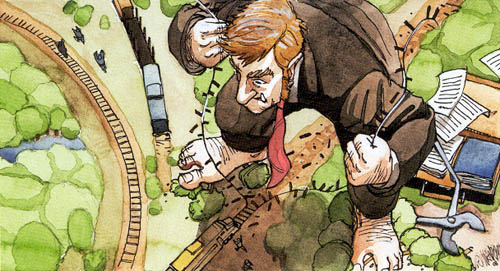 |
Fall 2008
|
Second Chance for a Valuable Route
By Greg Gormick

A rocky trail high in the Pocono
Mountains, east of Scranton, Pennsylvania, is not only awe inspiring, it's also the perfect place to contemplate the
recklessness that almost killed a huge segment of the North American railway system in the second half of the 20th
century.
This is all that remains of the Lackawanna or New Jersey Cut-off, a superbly engineered
right-of-way now silent and devoid of all things railway. The Lackawanna Railroad built the 28.5 mile
line between 1908 and 1911 to replace its original and difficult route through the Poconos and the Delaware Water
Gap. Fully grade-separated, the double track line cut 11.5 miles off the old route, reduced the grade
to 0.6 percent from 1.1 percent and eliminated curvature equal to four complete circles.
A second, similar cut-off, the Nicholson still serves as part of CP's Delaware & Hudson route from
Scranton to Binghamton. Together, these projects reshaped the Lackawanna, making it the shortest and fastest route
from Buffalo to New York. First in partnership with west-of-Buffalo railways and later as part of the
merged Erie Lackawanna, this route was a vital link in a fast freight chain from the Midwest to the Northeast. Then,
it all came tumbling down.
Excessive regulation and taxation, the decline of many northeastern industries, and competition from truckers on
publicly-funded interstates led to the bankruptcy of the Erie Lackawanna and the rest of the
northeastern railways by the 1970s. The result was the merging of these railways into government owned Conrail,
which would deliver the final blow to the Cut-off.
Conrail admittedly had too many routes from New York to Buffalo. When it pruned this system, it ditched the
high-speed Lackawanna Cut-off and kept the parallel Erie and Lehigh Valley lines to the
Binghamton area. This was understandable in that the Lehigh Valley served major steel mills (which are now closed)
and the Erie had fewer grades, even if it was longer, slower, and loaded with curves. But what happened next was an
act of sheer spite and recklessness.
The D&H was designated to preserve rail competition through an extensive series of trackage rights over Conrail
lines to New York, Philadelphia, and Washington. To say Conrail made life difficult for the D&H on its tracks is
an understatement. Conrail delays to D&H trains were maddening. Conrail dispatchers used to say they owned the
main lines and the D&H owned the sidings. This helped bankrupt the D&H.
One partial solution to this government sanctioned massacre would have been acquisition of the Cut-off
by the D&H, ending its reliance on Conrail to get to New York. Knowing this might happen, Conrail ripped up the
Cut-off to prevent the D&H or any other railway from getting it. It sold the
right-of-way to a construction company, which wanted to suck up the gravel in the high fills that
carried the line across numerous valleys.
This amounted to corporate vandalism and a restraint of competition, but the U.S. government couldn't have cared
less. After all, it owned Conrail. So much for the great American love affair with free enterprise and competition.
Fortunately, this story has a happy ending. A small band of enlightened local politicians and rail advocates pushed
the states of Pennsylvania and New Jersey to buy back the Cut-off from the construction firm. Now, it
is about to awaken from its 30-year slumber. It is slated for rebuilding as a passenger route from New
York to the Pocono resort towns and Scranton under the auspices of New Jersey Transit.
Some wonder if it might not also become a freight route again, too. These advocates have even suggested CP'S
D&H. They note that D&H trains on the Cut-offwould be free from the congestion on Norfolk
Southern's busy ex-Conrail/Lehigh Valley route from Newark to Wilkes-Barre, near Scranton.
It's also 50 miles shorter.
The revival of the Lackawanna Cut-off proves we sometimes do get second chances. Best to not even think
of the waste involved in abandoning this fabulous piece of railway and then resuscitating it. Better to hope there
are people in high places wise enough to not let this happen again. Our society, our economy, and our railway's
can't afford it.
 |
Greg Gormick is a Toronto-based contributing
editor of Railway Age. The views expressed are his own and do not necessarily reflect those of Canadian
Pacific or Railway Age. He may be reached at greg.gormick@gmail.com
|
This Momentum article is copyright
2008 by the Canadian Pacific Railway and is reprinted here with
their permission. All photographs, logos, and trademarks are the property of the Canadian Pacific Railway
Company.
|